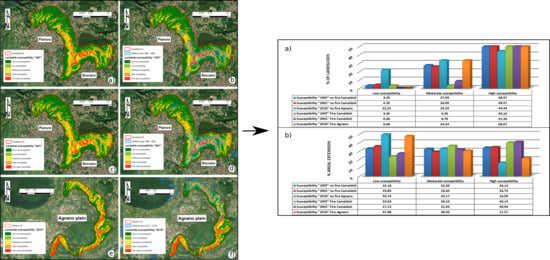Landslide Susceptibility Assessment of Wildfire Burnt Areas through Earth-Observation Techniques and a Machine Learning-Based Approach
Abstract
1. Introduction
2. Geological and Geomorphological Setting
3. Definition and Characteristics of Wildfires
- Ground fire, which burns without a flame in the organic layer above the mineral soil; its propagation is very slow and it can produce considerable damage to the soil, given its long residence time;
- Surface fire, which represents the most common fire propagation regime, during which a large class of plant substrate close to the topographic surface is consumed in flame combustion;
- Crown fire, which occurs when a surface fire that spreads under arboreal vegetation extends to the upper layers of the foliage; this fire can burn a single tree or a group of trees.
4. Materials and Methods
4.1. Landslide Inventory
4.2. Landslide Predisposing Factors
4.2.1. Slope Angle
4.2.2. Slope Aspect
4.2.3. Planform and Profile Curvature
4.2.4. Topographic Wetness Index (TWI)
4.2.5. Topographic Position Index (TPI)
4.2.6. Distance to Streams
4.2.7. Stream Density
4.2.8. Land Use
4.2.9. Geo-Lithological
4.2.10. Wildfire
4.3. Remote Sensing Modelling
4.3.1. Landsat Satellites
4.3.2. Sentinel-2 Satellite
4.4. Susceptibility Modelling Techniques
5. Fires and Slope Instability
- In the period immediately following the fire, the drying phenomenon (dry-ravel) can be triggered;
- Subsequently, with the first rainfall, processes of areal and linear erosion take place, which can lead to the development of debris flows;
- Finally, even after several seasonal cycles, translation slides can be triggered.
6. Results
7. Discussion
8. Conclusions
Author Contributions
Funding
Acknowledgments
Conflicts of Interest
References
- Calcaterra, D.; de Riso, R.; Evangelista, A.; Nicotera, M.V.; Santo, A.; Scotto Di Santolo, A. Slope instabilities of the pyroclastic deposits in the Phlegraean district and in the carbonate Apennine (Campania, Italy). In Proceedings of the Workshop on Occurrence and Mechanisms of Flows in Natural Slopes and Earth-fills, Sorrento, Italy, 14–16 May 2003. [Google Scholar]
- Trigila, A.; Frattini, P.; Casagli, N.; Catani, F.; Crosta, G.; Esposito, C.; Iadanza, C.; Lagomarsino, D.; Mugnozza, G.S.; Segoni, S.; et al. Landslide Susceptibility Mapping at National Scale: The Italian Case Study. In Landslide Science and Practice: Volume 1: Landslide Inventory and Susceptibility and Hazard Zoning; Margottini, C., Canuti, P., Sassa, K., Eds.; Springer: Berlin/Heidelberg, Germany, 2013; pp. 287–295. ISBN 978-3-642-31325-7. [Google Scholar]
- Segoni, S.; Tofani, V.; Rosi, A.; Catani, F.; Casagli, N. Combination of Rainfall Thresholds and Susceptibility Maps for Dynamic Landslide Hazard Assessment at Regional Scale. Front. Earth Sci. 2018, 6, 85. [Google Scholar] [CrossRef]
- Lombardo, L.; Mai, P.M. Presenting logistic regression-based landslide susceptibility results. Eng. Geol. 2018, 244, 14–24. [Google Scholar] [CrossRef]
- Cannon, S.H.; DeGraff, J. The Increasing Wildfire and Post-Fire Debris-Flow Threat in Western USA, and Implications for Consequences of Climate Change. In Landslides—Disaster Risk Reduction; Sassa, K., Canuti, P., Eds.; Springer: Berlin/Heidelberg, Germany, 2009; pp. 177–190. ISBN 978-3-540-69970-5. [Google Scholar]
- Nyman, P.; Sheridan, G.J.; Smith, H.G.; Lane, P.N.J. Evidence of debris flow occurrence after wildfire in upland catchments of south-east Australia. Geomorphology 2011, 125, 383–401. [Google Scholar] [CrossRef]
- Tien Bui, D.; Pradhan, B.; Lofman, O.; Revhaug, I. Landslide Susceptibility Assessment in Vietnam Using Support Vector Machines, Decision Tree, and Naïve Bayes Models. Available online: https://www.hindawi.com/journals/mpe/2012/974638/ (accessed on 18 May 2020).
- Di Martire, D.; De Rosa, M.; Pesce, V.; Santangelo, M.A.; Calcaterra, D. Landslide hazard and land management in high-density urban areas of Campania region, Italy. Nat. Hazards Earth Syst. Sci. 2012, 12, 905–926. [Google Scholar] [CrossRef]
- Pham, B.T.; Tien Bui, D.; Prakash, I.; Dholakia, M.B. Hybrid integration of Multilayer Perceptron Neural Networks and machine learning ensembles for landslide susceptibility assessment at Himalayan area (India) using GIS. Catena 2017, 149, 52–63. [Google Scholar] [CrossRef]
- Lombardo, L.; Opitz, T.; Huser, R. Point process-based modeling of multiple debris flow landslides using INLA: An application to the 2009 Messina disaster. Stoch Environ. Res. Risk Assess. 2018, 32, 2179–2198. [Google Scholar] [CrossRef]
- Scaramella, M. The Case of Naples, Italy, in Understanding Slums: Case Studies for the Global Report 2003, United Nations Human Settlements Programme, 21. Available online: http://www.ucl.ac.uk/dpu-projects/GlobalReport/home.htm (accessed on 18 May 2020).
- Totaro, F.; Alberico, I.; Di Martire, D.; Nunziata, C.; Petrosino, P. The key role of hazard indices and hotspot in disaster risk management: The case study of Napoli and Pozzuoli municipalities (Southern Italy). J. Maps 2020, 16, 68–78. [Google Scholar] [CrossRef]
- Calcaterra, D.; Coppin, D.; de Vita, S.; Di Vito, M.A.; Orsi, G.; Palma, B.; Parise, M. Slope processes in weathered volcaniclastic deposits within the city of Naples: The Camaldoli Hill case. Geomorphology 2007, 87, 132–157. [Google Scholar] [CrossRef]
- Calcaterra, D.; Guarino, P.M. Dinamica morfologica e fenomeni franosi recenti nell’area collinare napoletana (settore occidentale). Geol. Tech. Ambient. 1999, 2, 11–17. [Google Scholar]
- Meyer, G.A.; Wells, S.G. Fire-related sedimentation events on alluvial fans, Yellowstone National Park, U.S.A. J. Sediment. Res. 1997, 67, 776–791. [Google Scholar] [CrossRef]
- Cannon, S.H. Debris-flow generation from recently burned watersheds. Environ. Eng. Geosci. 2001, 7, 321–341. [Google Scholar] [CrossRef]
- Conedera, M.; Peter, L.; Marxer, P.; Forster, F.; Rickenmann, D.; Re, L. Consequences of forest fires on the hydrogeological response of mountain catchments: A case study of the Riale Buffaga, Ticino, Switzerland. Earth Surf. Process. Landf. 2003, 28, 117–129. [Google Scholar] [CrossRef]
- Cannon, S.H.; Bigio, E.; Mine, E. A process for fire-related debris flow initiation, Cerro Grande fire, New Mexico. Hydrol. Process. 2001, 15, 3011–3023. [Google Scholar] [CrossRef]
- Swanson, F.J. Fire and geomorphic processes. Fire Regime and Ecosystem Properties. In General Technical Report WO; Mooney, H.A., Bonnicksen, T.M., Christiansen, N.L., Lotan, J.E., Reiners, W.A., Eds.; United States Departement of Agriculture, Forest Service: Washington, DC, USA, 1981; Volume 26, pp. 401–421. [Google Scholar]
- Moody, J.A.; Martin, D.A. Post-fire, rainfall intensity–peak discharge relations for three mountainous watersheds in the western USA. Hydrol. Process. 2001, 15, 2981–2993. [Google Scholar] [CrossRef]
- Cannon, S.H.; Gartner, J.E.; Parrett, C.; Parise, M. Wildfire-related debris flow generation through episodic progressive sediment bulking processes, western U.S.A. Debris-Flow Hazards Mitigation—Mechanics, Prediction, and Assessment. In Proceedings of the Third International Conference on Debris-Flow Hazards Mitigation, Davos, Switzerland, 10–12 September 2003; Rickenmann, D., Chen, C.L., Eds.; A.A. Balkema: Rotterdam, The Netherlands, 2003; pp. 71–82. [Google Scholar]
- DeBano, L.F. Fire’s effect on physical and chemical properties of chaparral soils. In Proceedings of the Symposium on the Environmental Consequences of Fire and Fuel Management in Mediterranean Ecosystems, Palo Alto, CA, USA, 1–5 August 1977; For. Serv. Gen. Tech. Report. pp. 65–74. [Google Scholar]
- Giovannini, G.; Lucchesi, S.; Giachetti, M. Effect of heating on some physical and chemical parameters related to soil aggregation and erodibility. Soil Sci. 1988, 146, 255–261. [Google Scholar] [CrossRef]
- Wells, W. Some Effects of Brushfires on Erosion Processes in Coastal Southern California. In Erosion and Sediment Transport in Pacific Rim Steeplands; Davies, T.R.H., Pearce, A.J., Eds.; January 1981, Chirst Church, New Zealand. Sponsored jointly by the Royal Society of New Zealand, New Zealand Hydrological Society, IAHS, and the National Water and Soil Conservation Authority of New Zealand; International Association of Hydrologic Sciences Publication: Wellington, New Zealand, 1981; Volume 132, pp. 305–342. [Google Scholar]
- Giovannini, G.; Lucchesi, S. Effect of fire on hydrophobic and cementing substances of soil aggregates. Soil Sci. 1983, 136, 231–236. [Google Scholar] [CrossRef]
- Cannon, S.H.; Reneau, S.L. Conditions for generation of fire-related debris flows, Capulin Canyon, New Mexico. Earth Surf. Process. Landf. 2000, 25, 1103–1121. [Google Scholar] [CrossRef]
- De Graff, J.V. A rationale for effective post-fire debris flow mitigation within forested terrain. Geoenviron Disasters 2018, 5, 7. [Google Scholar] [CrossRef]
- Tonini, M.; D’Andrea, M.; Biondi, G.; Degli Esposti, S.; Trucchia, A.; Fiorucci, P. A Machine Learning-Based Approach for Wildfire Susceptibility Mapping. The Case Study of the Liguria Region in Italy. Geosciences 2020, 10, 105. [Google Scholar] [CrossRef]
- Gholamnia, K.; Gudiyangada Nachappa, T.; Ghorbanzadeh, O.; Blaschke, T. Comparisons of Diverse Machine Learning Approaches for Wildfire Susceptibility Mapping. Symmetry 2020, 12, 604. [Google Scholar] [CrossRef]
- Esposito, G.; Esposito, E.; Matano, F.; Molisso, F.; Sacchi, M.; Porfido, S. Effects of a wildfireon rocks and soils in the Sarno Mountains, Campania, Southern Apennines. Rendiconti Online Soc. Geol. Ital. 2013, 24, 119–121. [Google Scholar]
- Calcaterra, D.; Parise, M.; Strumia, S.; Mazzella, E. Relations Between Fire, Vegetation and Landslides in the Heavily Populated Metropolitan Area of Naples, Italy. In Proceedings of the 1st North American Landslide Conference, Vail, CO, USA, 3–8 June 2007; Schaefer, V.R., Schuster, R.L., Turner, A.K., Eds.; Association of Environmental & Engineering Geologists: Denver, CO, USA, 2007; pp. 1448–1461. [Google Scholar]
- Addabbo, P.; Focareta, M.; Marcuccio, S.; Votto, C.; Ullo, S.L. Contribution of Sentinel-2 data for applications in vegetation monitoring. ACTA IMEKO 2016, 5, 44–54. [Google Scholar] [CrossRef]
- Addabbo, P.; Focareta, M.; Marcuccio, S.; Votto, C.; Ullo, S.L. Land cover classification and monitoring through multisensor image and data combination. In Proceedings of the 2016 IEEE International Geoscience and Remote Sensing Symposium (IGARSS), Beijing, China, 10–15 July 2016; pp. 902–905. [Google Scholar]
- Fiscante, N.; Focareta, M.; Galdi, C.; Ullo, S.L. Analysis and validation of high-resolution satellite DEMs generated from EROS-B data for montaguto landslide. In Proceedings of the 2012 IEEE International Geoscience and Remote Sensing Symposium, Munich, Germany, 22–27 July 2012; pp. 7549–7552. [Google Scholar]
- Cicala, L.; Angelino, C.V.; Fiscante, N.; Ullo, S.L. Landsat-8 and Sentinel-2 for fire monitoring at a local scale: A case study on Vesuvius. In Proceedings of the 2018 IEEE International Conference on Environmental Engineering (EE), Milan, Italy, 12–14 March 2018; pp. 1–6. [Google Scholar]
- Cicala, L.; Angelino, C.V.; Parrilli, S.; Fiscante, N.; Ullo, S.L.; Addabbo, P. Unsupervised Post-Fire Assessment of Burned Areas with Free and Open Multispectral Data Using OBIA. In Proceedings of the GEOBIA 2018–From Pixels to Ecosystems and Global Sustainability; Centre d’Etudes Spatiales de la BIOsphère (CESBIO) and Office National D’études et de Recherches Aérospatiales (ONERA) and Espace pour le Développement (ESPACE DEV) and Société T.E.T.I.S: Montpellier, France, 2018. [Google Scholar]
- Tien Bui, D. land cover change mapping using a combination of sentinel-1 data and multispectral satellite imagery: A case study of sanandaj county, kurdistan, Iran. Appl. Ecol. Environ. Res. 2019, 17, 5449–5463. [Google Scholar] [CrossRef]
- De Vivo, B.; Rolandi, G.; Gans, P.B.; Calvert, A.; Bohrson, W.A.; Spera, F.J.; Belkin, H.E. New constraints on the pyroclastic eruptive history of the Campanian volcanic Plain (Italy). Mineral. Petrol. 2001, 73, 47–65. [Google Scholar] [CrossRef]
- Deino, A.L.; Orsi, G.; de Vita, S.; Piochi, M. The age of the Neapolitan Yellow Tuff caldera-forming eruption (Campi Flegrei caldera–Italy) assessed by 40Ar/39Ar dating method. J. Volcanol. Geotherm. Res. 2004, 133, 157–170. [Google Scholar] [CrossRef]
- Orsi, G.; D’Antonio, M.; de Vita, S.; Gallo, G. The Neapolitan Yellow Tuff, a large-magnitude trachytic phreatoplinian eruption: Eruptive dynamics, magma withdrawal and caldera collapse. J. Volcanol. Geotherm. Res. 1992, 53, 275–287. [Google Scholar] [CrossRef]
- Orsi, G.; De Vita, S.; di Vito, M. The restless, resurgent Campi Flegrei nested caldera (Italy): Constraints on its evolution and configuration. J. Volcanol. Geotherm. Res. 1996, 74, 179–214. [Google Scholar] [CrossRef]
- Morra, V.; Calcaterra, D.; Cappelletti, P.; Colella, A.; Fedele, L.; De Gennaro, R.; Langella, A.; Mercurio, M.; De Gennaro, M. Urban geology: Relationships between geological setting and architectural heritage of the Neapolitan area. J. Virtual Explor. 2010, 36, 1–59. [Google Scholar] [CrossRef]
- Pappalardo, L.; Civetta, L.; D’Antonio, M.; Deino, A.; Di Vito, M.; Orsi, G.; Carandente, A.; de Vita, S.; Isaia, R.; Piochi, M. Chemical and Sr-isotopical evolution of the Phlegraean magmatic system before the Campanian Ignimbrite and the Neapolitan Yellow Tuff eruptions. J. Volcanol. Geotherm. Res. 1999, 91, 141–166. [Google Scholar] [CrossRef]
- Fedele, F.G.; Giaccio, B.; Isaia, R.; Orsi, G. The Campanian Ignimbrite Eruption, Heinrich Event 4, and Palaeolithic Change in Europe: A High-Resolution Investigation. In Volcanism and the Earth’s Atmosphere; American Geophysical Union (AGU): Naples, Italy, 2013; pp. 301–325. ISBN 978-1-118-66854-2. [Google Scholar]
- Scarpati, C.; Perrotta, A.; Sparice, D. Volcanism in the city of Naples. Rendicondi Online Soc. Geol. Ital. 2015, 33, 88–91. [Google Scholar] [CrossRef]
- Shakesby, R.A.; Doerr, S.H. Wildfire as a hydrological and geomorphological agent. Earth Sci. Rev. 2006, 74, 269–307. [Google Scholar] [CrossRef]
- Whelan, R.J. The Ecology of Fire; Cambridge University Press: Cambridge, UK, 1995. [Google Scholar]
- Neary, D.G.; Klopatek, C.C.; DeBano, L.F.; Ffolliott, P.F. Fire effects on belowground sustainability: A review and synthesis. For. Ecol. Manag. 1999, 122, 51–71. [Google Scholar] [CrossRef]
- Prosser, I. Fire, Humans and Denudation at Wangrah Creek, Southern Tablelands, N.S.W. Aust. Geograph. Stud. 1990, 28, 77–95. [Google Scholar] [CrossRef]
- Inbar, M.; Tamir, M.; Wittenberg, L. Runoff and erosion processes after a forest fire in Mount Carmel, a Mediterranean area. Geomorphology 1998, 24, 17–33. [Google Scholar] [CrossRef]
- Neary, D.G.; Ryan, K.C.; DeBano, L.F. (Eds.) Wildland Fire Inecosystems: Effects of Fire on Soils and Water; revised 2008. In General Technical Report RMRS-GTR-42; U.S. Department of Agriculture, Forest Service, Rocky Mountain Research Station: Ogden, UT, USA, 2005; Volume 4, 250p. [Google Scholar]
- Giovannini, G.; Lucchesi, S. Effects of Fire on Soil Physico-Chemical Characteristics and Erosion Dynamics. In Fire in Mediterranean Ecosystems; Trabaud, L., Prodon, R., Eds.; Commission of the European Communities: Brussels, Belgium, 1993; pp. 403–412. [Google Scholar]
- Giovannini, G.; Lucchesi, S. Modifications induced in soil physico-chemical parameters by experimental fires at different intensities. Soil Sci. 1997, 162, 479–486. [Google Scholar] [CrossRef]
- Wondzell, S.M.; King, J.G. Postfire erosional processes in the Pacific Northwest and Rocky Mountain regions. For. Ecol. Manag. 2003, 178, 75–87. [Google Scholar] [CrossRef]
- Savage, S.M. Mechanism of Fire-Induced Water Repellency in Soil. Soil Sci. Soc. Am. J. 1974, 38, 652–657. [Google Scholar] [CrossRef]
- Franco, C.M.M.; Clarke, P.J.; Tate, M.E.; Oades, J.M. Hydrophobic properties and chemical characterisation of natural water repellent materials in Australian sands. J. Hydrol. 2000, 231–232, 47–58. [Google Scholar] [CrossRef]
- Chandler, C.; Cheney, P.; Thomas, P.; Trabaud, L.; Williams, D. Fire in Forestry. Volume 1. Forest Fire Behavior and Effects. Volume 2. Forest Fire Management and Organization; John Wiley & Sons: New York, NY, USA, 1983. [Google Scholar]
- De Bano, L.F. The effects of fire on soil properties. For. Soils 1981, 151–155. [Google Scholar]
- Marxer, P.; Conedera, M. Experimental Fire in Switzerland. Final Report of the Prometheus System Validation Project; EU Project No. PL971037; Swiss Federal Research Institute, Sottostazione Sud delle Alpi: Bellinzona, Switzerland, 2000. [Google Scholar]
- Gartner, J.E.; Bigio, E.R.; Cannon, S.H. Compilation of Post Wildfire Runoff-Event Data from the Western United States; Open-File Report, 04-1085; United States Geological Survey: Reston, VA, USA, 2004. [CrossRef]
- Zavala, L.M.; Jordán, A.; Gil, J.; Bellinfante, N.; Pain, C. Intact ash and charred litter reduces susceptibility to rain splash erosion post-wildfire. Earth Surf. Process. Landf. 2009, 34, 1522–1532. [Google Scholar] [CrossRef]
- Zavala, L.M.M.; de Celis Silvia, R.; López, A.J. How wildfires affect soil properties. A brief review. Cuadernos de Investig. Geográfica/Geograph. Res. Lett. 2014, 40, 311–331. [Google Scholar] [CrossRef]
- Santi, P.M.; Morandi, L. Comparison of debris-flow volumes from burned and unburned areas. Landslides 2013, 10, 757–769. [Google Scholar] [CrossRef]
- DeGraff, J.V.; Cannon, S.H.; Gartner, J.E. The Timing of Susceptibility to Post-Fire Debris Flows in the Western United StatesPost-fire Debris Flow Timing. Environ. Eng. Geosci. 2015, 21, 277–292. [Google Scholar] [CrossRef]
- Staley, D.M.; Negri, J.A.; Kean, J.W.; Laber, J.L.; Tillery, A.C.; Youberg, A.M. Prediction of spatially explicit rainfall intensity–duration thresholds for post-fire debris-flow generation in the western United States. Geomorphology 2017, 278, 149–162. [Google Scholar] [CrossRef]
- van Westen, C.J.; Castellanos, E.; Kuriakose, S.L. Spatial data for landslide susceptibility, hazard, and vulnerability assessment: An overview. Eng. Geol. 2008, 102, 112–131. [Google Scholar] [CrossRef]
- Corominas, J.; van Westen, C.; Frattini, P.; Cascini, L.; Malet, J.-P.; Fotopoulou, S.; Catani, F.; Van Den Eeckhaut, M.; Mavrouli, O.; Agliardi, F.; et al. Recommendations for the quantitative analysis of landslide risk. Bull. Eng. Geol. Environ. 2014, 73, 209–263. [Google Scholar] [CrossRef]
- Finicelli, G.F.; Confuorto, P.; Carratù, M.T.; Di Martire, D. Multivariate Statistical approach vs. Deterministic physically based model for landslide susceptibility assessment. Rendicondi Online Soc. Geol. Ital. 2016, 41, 151–154. [Google Scholar] [CrossRef]
- Cruden, D.M.; Varnes, D.J. Landslides: Investigation and Mitigation; Chapter 3–Landslide Types and Processes. In Transport Research Board Special Report; Turner, K.A., Schuster, R.L., Eds.; The National Academies of Sciences, Engineering, and Medicine: Washington, DC, USA, 1996; Volume 247, pp. 36–75. [Google Scholar]
- Hungr, O. Review of the classification of landslides of the flow type. Environ. Eng. Geosci. 2001, 7, 221–238. [Google Scholar] [CrossRef]
- Kornejady, A.; Ownegh, M.; Bahremand, A. Landslide susceptibility assessment using maximum entropy model with two different data sampling methods. CATENA 2017, 152, 144–162. [Google Scholar] [CrossRef]
- Sadr, M.P.; Maghsoudi, A.; Saljoughi, B.S. Landslide susceptibility mapping of komroud sub-basin using Fuzzy logic approach. Proc. Geodynam. Res. Int. Bull. 2014, 2, XVI–XXVIII. [Google Scholar]
- Rahmati, O.; Pourghasemi, H.R.; Melesse, A.M. Application of GIS-based data driven random forest and maximum entropy models for groundwater potential mapping: A case study at Mehran Region, Iran. CATENA 2016, 137, 360–372. [Google Scholar] [CrossRef]
- Pourghasemi, H.R.; Pradhan, B.; Gokceoglu, C. Application of fuzzy logic and analytical hierarchy process (AHP) to landslide susceptibility mapping at Haraz watershed, Iran. Nat. Hazards 2012, 2, 965–996. [Google Scholar] [CrossRef]
- Beven, K.J.; Kirby, M.J. A physically based, variable contributing area model of basin hydrology. Hydrol. Sci. Bull. 1979, 24, 43–69. [Google Scholar] [CrossRef]
- Wilson, J.P.; Gallant, J.C. Digital terrain analysis. Terrain Anal. Princ. Appl. 2000, 6, 1–27. [Google Scholar]
- Shirzadi, A.; Bui, D.T.; Pham, B.T.; Solaimani, K.; Chapi, K.; Kavian, A.; Shahabi, H.; Revhaug, I. Shallow landslide susceptibility assessment using a novel hybrid intelligence approach. Environ. Earth Sci. 2017, 76, 60. [Google Scholar] [CrossRef]
- Barlow, J.; Martin, Y.; Franklin, S.E. Detecting translational landslide scars using segmentation of Landsat ETM+ and DEM data in the northern Cascade Mountains, British Columbia. Can. J. Remote Sens. 2003, 29, 510–517. [Google Scholar] [CrossRef]
- Chen, W.; Moriya, K.; Sakai, T.; Koyama, L.; Cao, C.X. Mapping a burned forest area from Landsat TM data by multiple methods. Geom. Nat. Hazards Risk 2016, 7, 384–402. [Google Scholar] [CrossRef]
- Congedo, L. Semi-Automatic Classification Plugin Documentation. Release 2016, 4, 29. [Google Scholar]
- Yalcin, A.; Reis, S.; Aydinoglu, A.C.; Yomralioglu, T. A GIS-based comparative study of frequency ratio, analytical hierarchy process, bivariate statistics and logistics regression methods for landslide susceptibility mapping in Trabzon, NE Turkey. CATENA 2011, 85, 274–287. [Google Scholar] [CrossRef]
- Goetz, J.N.; Brenning, A.; Petschko, H.; Leopold, P. Evaluating machine learning and statistical prediction techniques for landslide susceptibility modeling. Comput. Geosci. 2015, 81, 1–11. [Google Scholar] [CrossRef]
- Sepe, C.; Confuorto, P.; Angrisani, A.C.; Di Martire, D.; Di Napoli, M.; Calcaterra, D. Application of a Statistical Approach to Landslide Susceptibility Map Generation in Urban Settings. In IAEG/AEG Annual Meeting Proceedings, San Francisco, California, 2018–Volume 1; Shakoor, A., Cato, K., Eds.; Springer International Publishing: Cham, Switzerland, 2019; pp. 155–162. [Google Scholar]
- Xiao, T.; Yin, K.; Yao, T.; Liu, S. Spatial prediction of landslide susceptibility using GIS-based statistical and machine learning models in Wanzhou County, Three Gorges Reservoir, China. Acta Geochim. 2019, 38, 654–669. [Google Scholar] [CrossRef]
- Segoni, S.; Lagomarsino, D.; Fanti, R.; Moretti, S.; Casagli, N. Integration of rainfall thresholds and susceptibility maps in the Emilia Romagna (Italy) regional-scale landslide warning system. Landslides 2015, 12, 773–785. [Google Scholar] [CrossRef]
- Lombardo, L.; Bachofer, F.; Cama, M.; Märker, M.; Rotigliano, E. Exploiting Maximum Entropy method and ASTER data for assessing debris flow and debris slide susceptibility for the Giampilieri catchment (north-eastern Sicily, Italy). Earth Surf. Process. Landf. 2016, 41, 1776–1789. [Google Scholar] [CrossRef]
- Carotenuto, F.; Angrisani, A.C.; Bakthiari, A.; Carratù, M.T.; Di Martire, D.; Finicelli, G.F.; Raia, P.; Calcaterra, D. A New Statistical Approach for Landslide Susceptibility Assessment in the Urban Area of Napoli (Italy). In Workshop on World Landslide Forum; Mikos, M., Tiwari, B., Yin, Y., Sassa, K., Eds.; Springer International Publishing: Cham, Switzerland, 2017; pp. 881–889. [Google Scholar]
- Di Napoli, M.; Carotenuto, F.; Cevasco, A.; Confuorto, P.; Di Martire, D.; Firpo, M.; Pepe, G.; Raso, E.; Calcaterra, D. Machine learning ensemble modelling as a tool to improve landslide susceptibility mapping reliability. Landslides 2020, 17, 1897–1914. [Google Scholar] [CrossRef]
- The R Project for Statistical Computing R: A Language and Environment for Statistical Computing. Available online: https://www.r-project.org/ (accessed on 19 May 2020).
- Elith, J.; Graham, C.H.; Anderson, R.P.; Dudík, M.; Ferrier, S.; Guisan, A.; Hijmans, R.J.; Huettmann, F.; Leathwick, J.R.; Lehmann, A.; et al. Novel methods improve prediction of species’ distributions from occurrence data. Ecography 2006, 29, 129–151. [Google Scholar] [CrossRef]
- Araújo, M.B.; Pearson, R.G.; Thuiller, W.; Erhard, M. Validation of species–climate impact models under climate change. Glob. Chang. Biol. 2005, 11, 1504–1513. [Google Scholar] [CrossRef]
- Thuiller, W.; Lafourcade, B.; Engler, R.; Araújo, M.B. BIOMOD—A platform for ensemble forecasting of species distributions. Ecography 2009, 32, 369–373. [Google Scholar] [CrossRef]
- Stokes, A.; Atger, C.; Bengough, A.G.; Fourcaud, T.; Sidle, R.C. Desirable plant root traits for protecting natural and engineered slopes against landslides. Plant Soil 2009, 324, 1–30. [Google Scholar] [CrossRef]
- Preti, F. Forest protection and protection forest: Tree root degradation over hydrological shallow landslides triggering. Ecol. Eng. 2013, 61, 633–645. [Google Scholar] [CrossRef]
- Vergani, C.; Giadrossich, F.; Buckley, P.; Conedera, M.; Pividori, M.; Salbitano, F.; Rauch, H.; Lovreglio, R.; Schwarz, M. Root reinforcement dynamics of European coppice woodlands and their effect on shallow landslides: A review. Earth Sci. Rev. 2017, 167, 88–102. [Google Scholar] [CrossRef]
- Meisina, C.; Bordoni, M.; Vercesi, A.; Maerker, M.; Ganimede, C.; Reguzzi, M.C.; Capelli, E.; Mazzoni, E.; Simoni, S.; Gagnarli, E. Effects of Vineyard Inter-Row Management on Soils, Roots and Shallow Landslides Probability in the Apennines, Lombardy, Italy. Proceedings 2019, 30, 41. [Google Scholar] [CrossRef]
- Sidle, R.C.; Dhakal, A.S. Potential effects of environmental change on landslide hazards in forest environments. Environ. Chang. Geomorph. Hazards For. 2002, 123–165. [Google Scholar]
- Ma, K.-C.; Lin, Y.-J.; Maa, S.-Y.; Tan, Y.-C. Evaluation of the effect of hysteretic flow and root system on shallow landslide. Soil Res. 2012, 50, 616–624. [Google Scholar] [CrossRef]
- Dias, A.S.; Pirone, M.; Urciuoli, G. Review on Types of Root Failures in Shallow Landslides. In Workshop on World Landslide Forum; Mikos, M., Tiwari, B., Yin, Y., Sassa, K., Eds.; Springer International Publishing: Cham, Switzerland, 2017; pp. 633–640. [Google Scholar]
- Amato, M.; Di Martino, P.; Di Pasquale, G.; Mazzoleni, S.; Migliozzi, A.; Strumia, S. Il ruolo della vegetazione nelle frane di Quindici. Quad. Geol. Appl. 2000, 7, 97–108. [Google Scholar]
- Tien Bui, D.; Bui, Q.-T.; Nguyen, Q.-P.; Pradhan, B.; Nampak, H.; Trinh, P.T. A hybrid artificial intelligence approach using GIS-based neural-fuzzy inference system and particle swarm optimization for forest fire susceptibility modeling at a tropical area. Agric. For. Meteorol. 2017, 233, 32–44. [Google Scholar] [CrossRef]
- Arabameri, A.; Pourghasemi, H.R.; Yamani, M. Applying different scenarios for landslide spatial modeling using computational intelligence methods. Environ. Earth Sci. 2017, 76, 832. [Google Scholar] [CrossRef]
- Arabameri, A.; Pradhan, B.; Lombardo, L. Comparative assessment using boosted regression trees, binary logistic regression, frequency ratio and numerical risk factor for gully erosion susceptibility modelling. CATENA 2019, 183, 104223. [Google Scholar] [CrossRef]
- Guisan, A.; Thuiller, W.; Zimmermann, N.E. Habitat Suitability and Distribution Models: With Applications in R; Cambridge University Press: Cambridge, UK, 2017; ISBN 978-0-521-76513-8. [Google Scholar]
- Hair, J.F.; Black, W.C.; Babin, B.J.; Anderson, R.E. Multivariate Data Analysis: A Global Perspective, 7th ed.; Pearson Education Inc.: New Jersey, NJ, USA, 2010. [Google Scholar]
- Jenks, G.F. The Data Model Concept in Statistical Mapping. International Yearbook of Cartography; University of Ulm: Ulm, Germany, 1967; Volume 7, pp. 186–190. [Google Scholar]
- Donner, R.V.; Barbosa, S.M. Nonlinear Time Series Analysis in the Geosciences: Applications in Climatology, Geodynamics and Solar-Terrestrial Physics; Springer: Berlin/Heidelberg, Germany, 2008. [Google Scholar]
- Swets, J.A. Measuring the accuracy of diagnostic systems. Science 1988, 240, 1285–1293. [Google Scholar] [CrossRef]
- Peterson, A.T.; Papeş, M.; Soberón, J. Rethinking receiver operating characteristic analysis applications in ecological niche modeling. Ecol. Model. 2008, 213, 63–72. [Google Scholar] [CrossRef]
- Corsini, A.; Mulas, M. Use of ROC curves for early warning of landslide displacement rates in response to precipitation (Piagneto landslide, Northern Apennines, Italy). Landslides 2017, 14, 1241–1252. [Google Scholar] [CrossRef]
- Allouche, O.; Tsoar, A.; Kadmon, R. Assessing the accuracy of species distribution models: Prevalence, kappa and the true skill statistic (TSS). J. Appl. Ecol. 2006, 43, 1223–1232. [Google Scholar] [CrossRef]
- Coetzee, B.W.T.; Robertson, M.P.; Erasmus, B.F.N.; Rensburg, B.J.V.; Thuiller, W. Ensemble models predict Important Bird Areas in southern Africa will become less effective for conserving endemic birds under climate change. Glob. Ecol. Biogeogr. 2009, 18, 701–710. [Google Scholar] [CrossRef]
- Thuiller, W.; Georges, D.; Engler, R.; Breiner, F. Biomod2: Ensemble platform for species distribution modeling. R Package Version 2016, 2, r560. [Google Scholar]
- Pourghasemi, H.R.; Rahmati, O. Prediction of the landslide susceptibility: Which algorithm, which precision? CATENA 2018, 162, 177–192. [Google Scholar] [CrossRef]
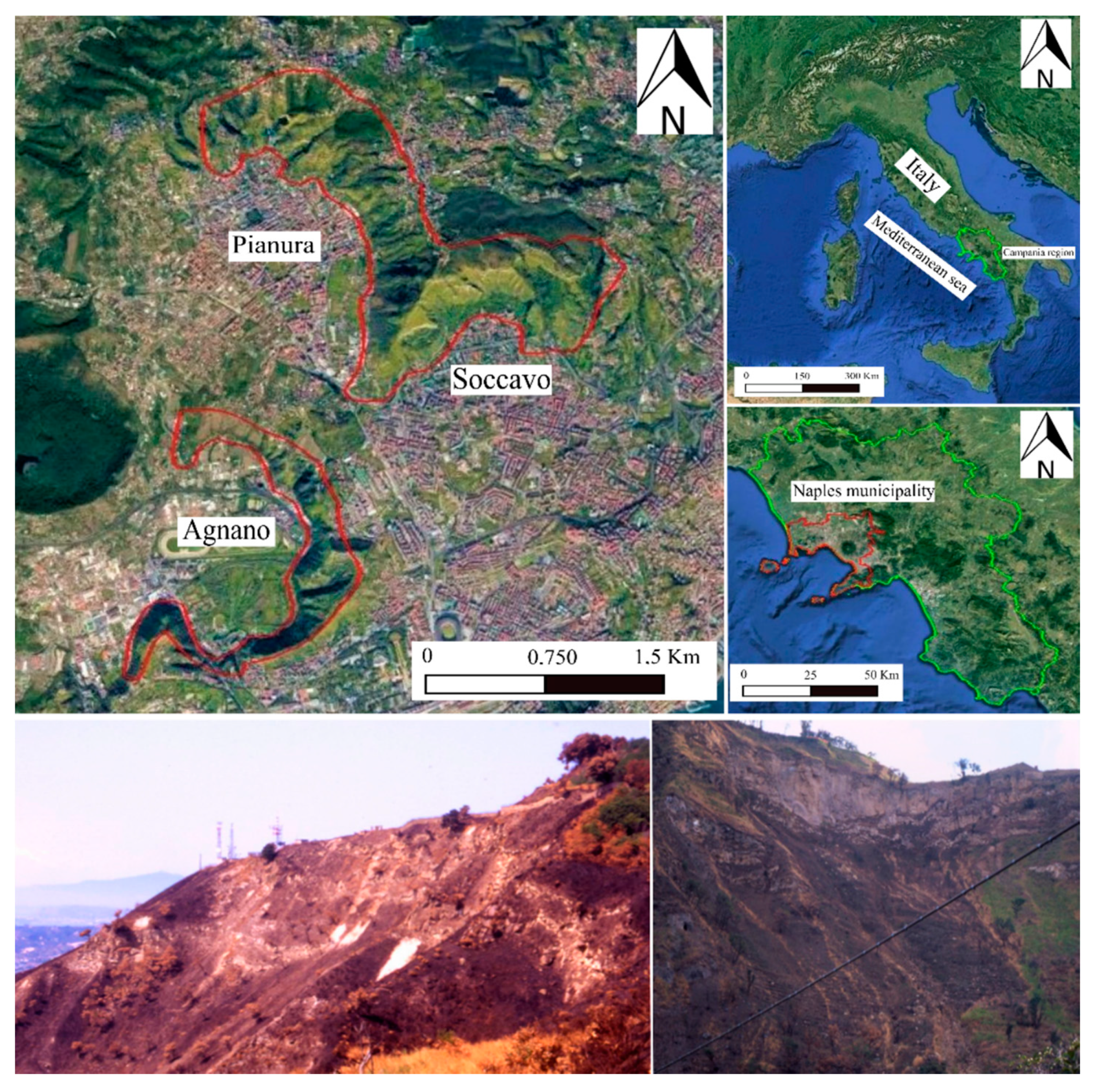
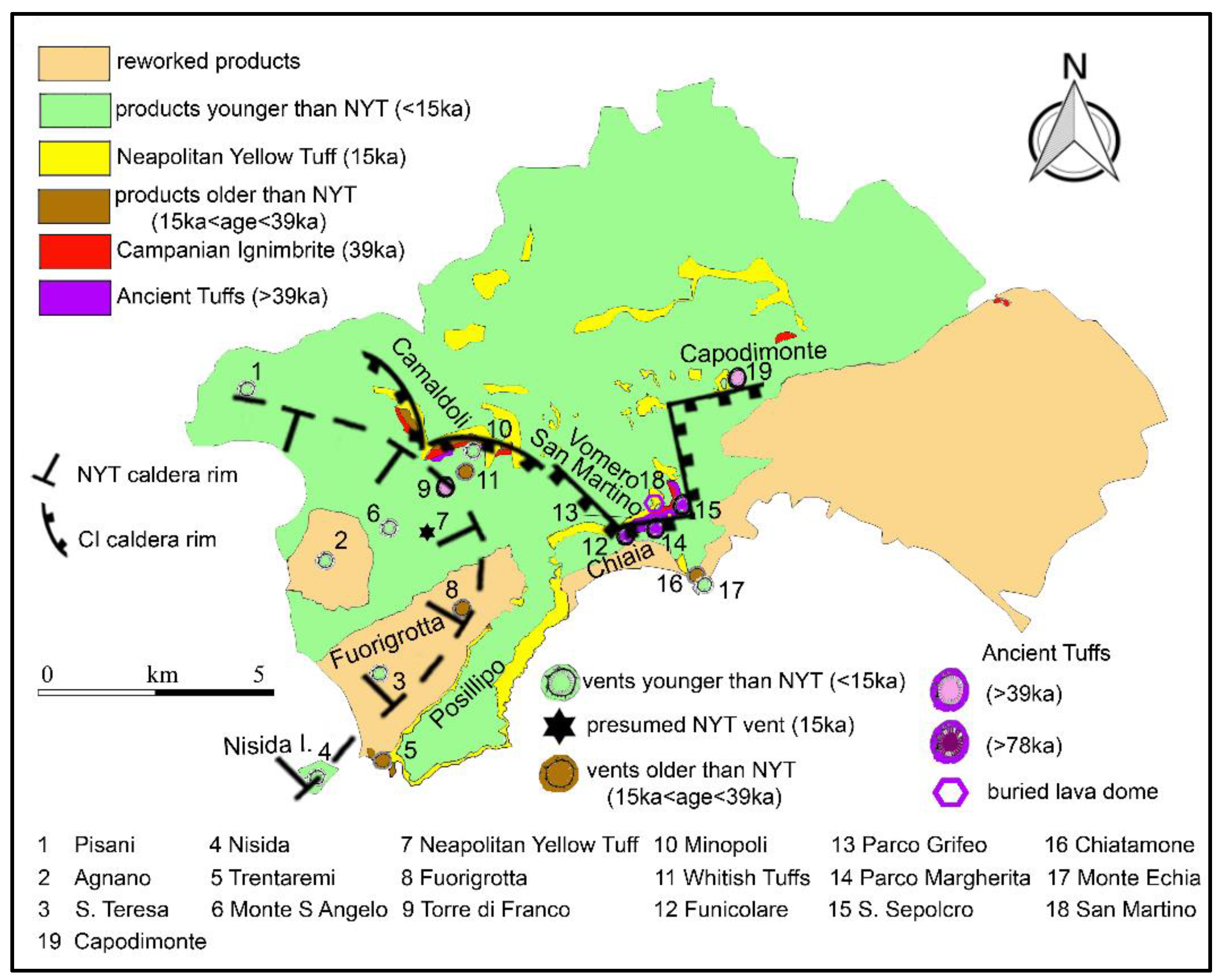
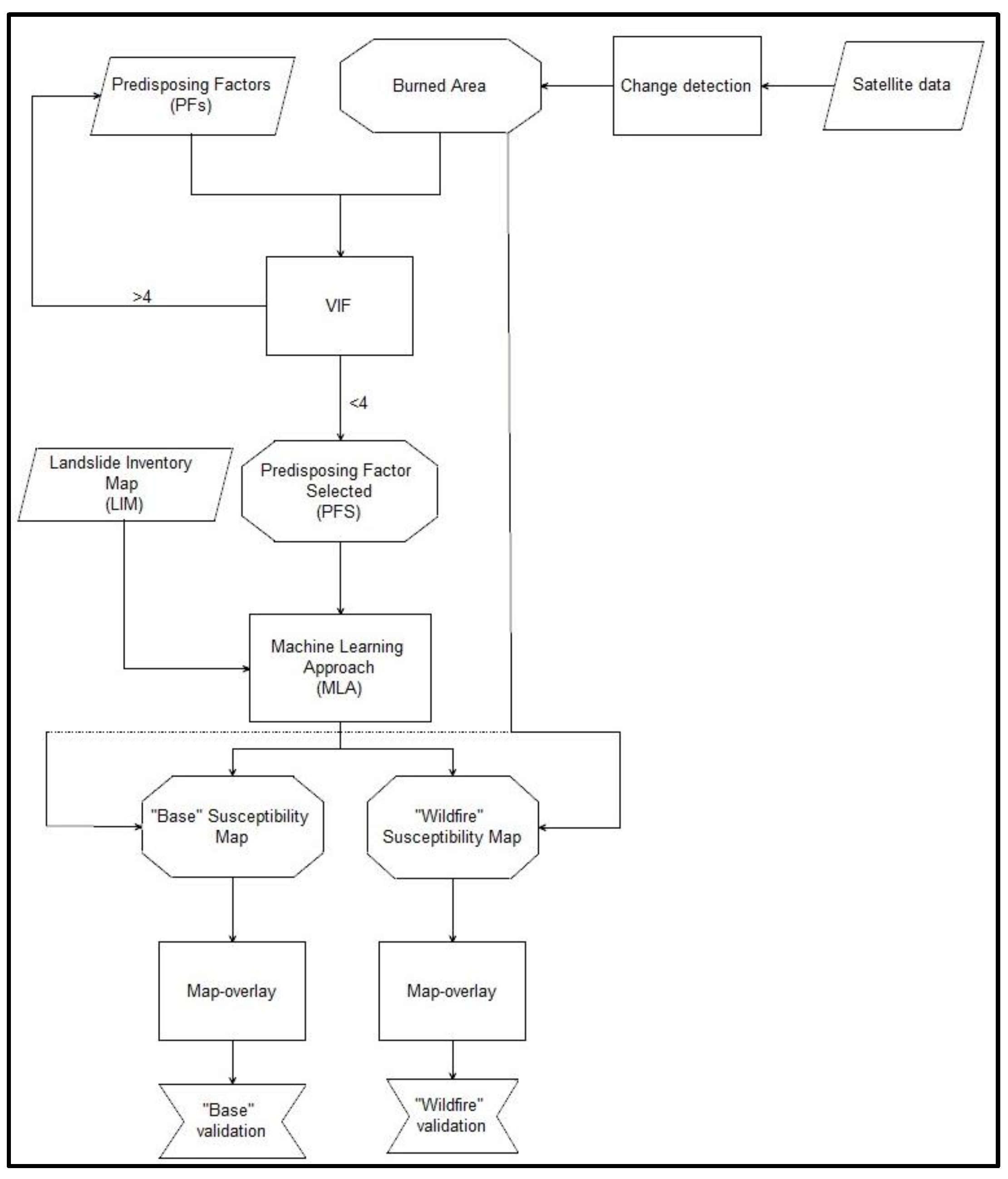

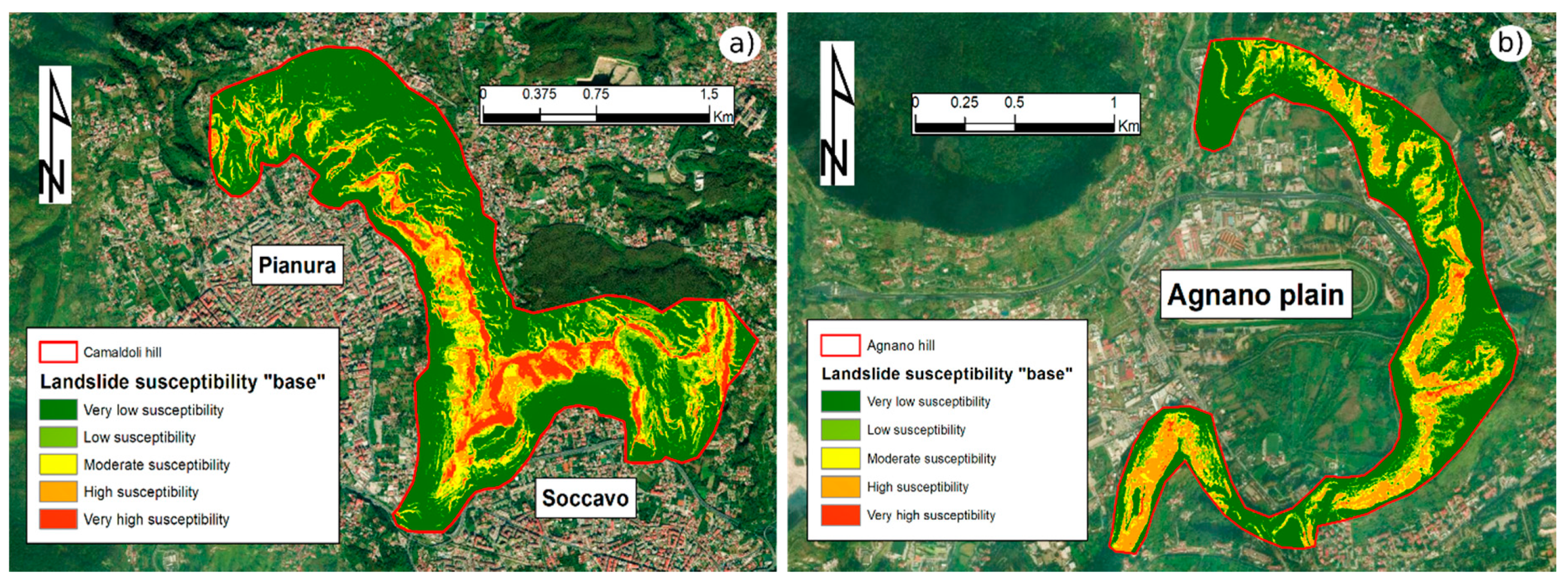

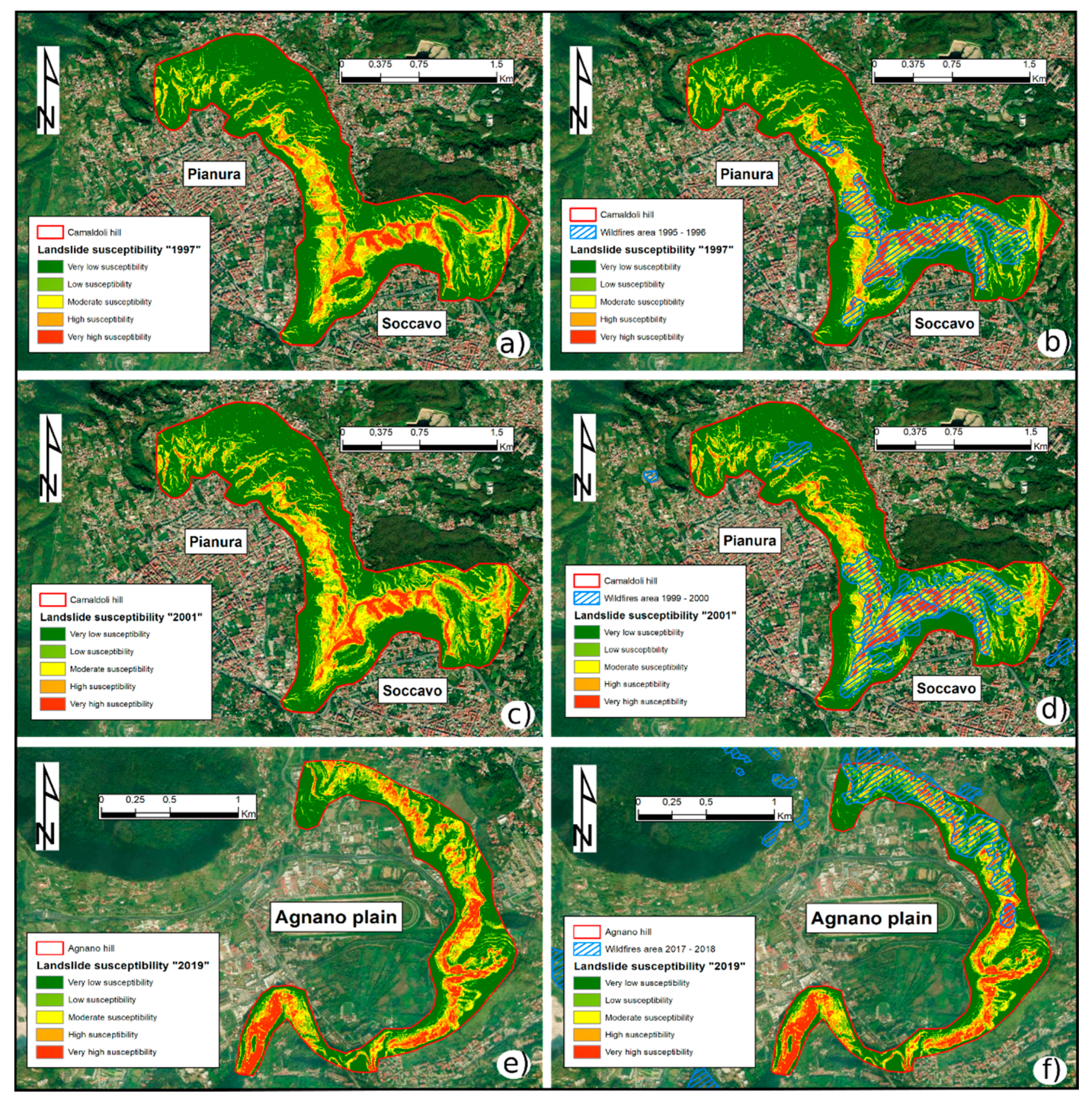

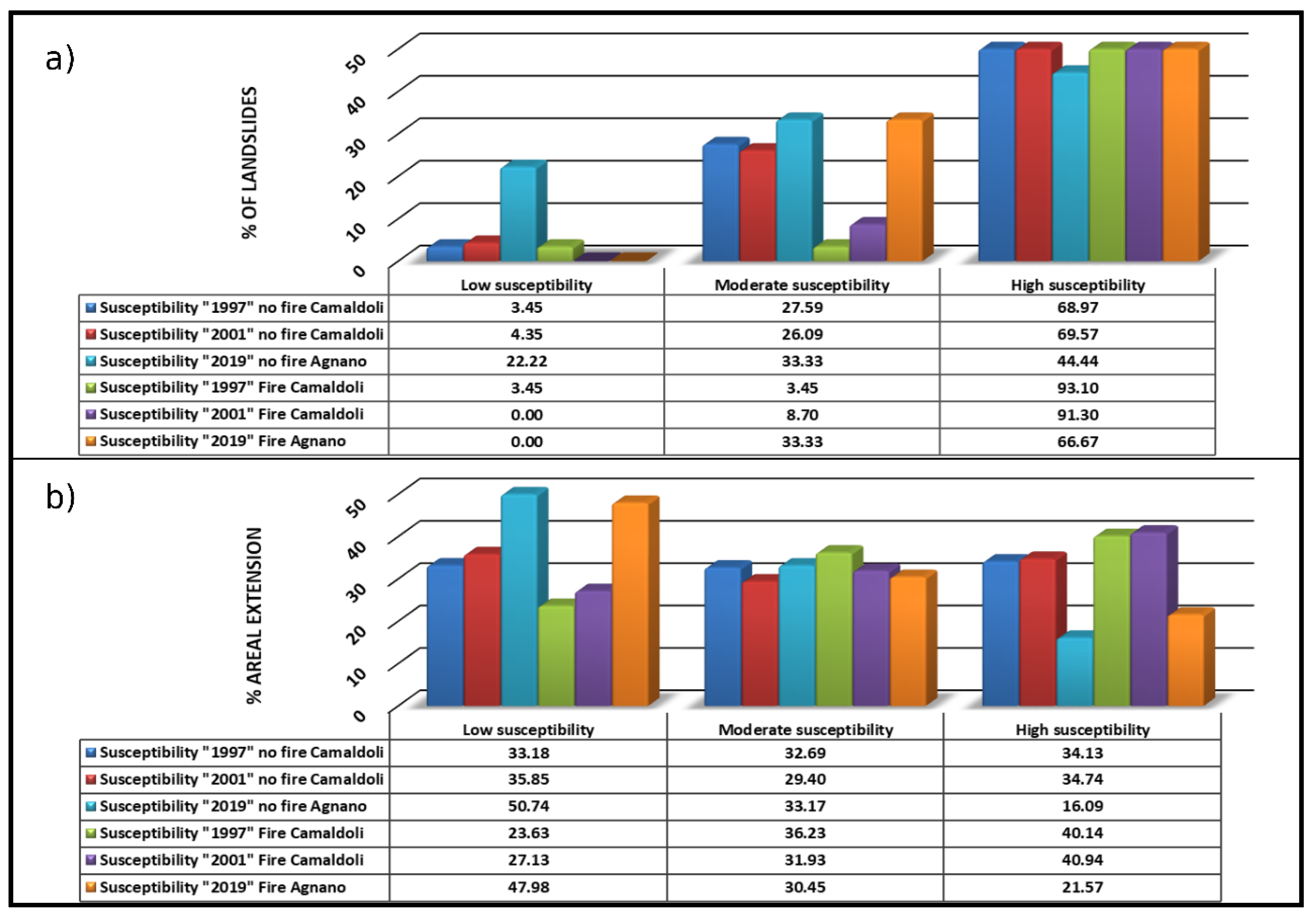
| Land-Use Types Code | Brief Description |
|---|---|
| 1 | Urbanized residential areas cover more than 80% of the total area. |
| 2 | Urbanized residential areas made up of buildings and roads are between 80% and 30% of the total area. |
| 3 | Areas occupied by buildings used for production activities, factory and commercial units. |
| 4 | Areas covered by vegetation that reach the surface of 0.5 ha. This includes urban parks, municipal villas, public and private gardens. |
| 5 | All sports areas are included in the class. |
| 6 | Fruit trees and berry plantations. |
| 7 | The class includes low productivity forage areas. They are often located in rough areas. |
| 8 | Mosaic of land that cannot be individually mapped with various temporary crops, stable lawns and permanent crops, each occupying less than 50% of the total area. |
| 9 | This class includes crops interrupted by natural forest areas of considerable size. Crops occupy more than 25 and less than 75% of the total area. |
| 10 | Broad-leaved forest |
| 11 | Sclerophyllous vegetation is a plant association of Mediterranean environments made up of trees with arboreal growth. |
| 12 | This class is formed by shrub or herbaceous vegetation with scattered trees. |
| Landsat 4-5 Bands | Wavelength [micrometres] | Resolution [meters] |
|---|---|---|
| Band 7—SWIR | 2.09–2.35 | 30 |
| Band 4—Near Infrared (NIR) | 0.77–0.90 | 30 |
| Band 2—Green | 0.52–0.60 | 30 |
| Sentinel-2 Bands | Central Wavelength [μm] | Resolution [m] |
|---|---|---|
| Band 3—Green | 0.560 | 10 |
| Band 4—Red | 0.665 | 10 |
| Band 6—Vegetation Red Edge | 0.740 | 20 |
| Band 7—Vegetation Red Edge | 0.783 | 20 |
| Band 11—SWIR | 1.610 | 20 |
| Band 12—SWIR | 2.190 | 20 |
| Camaldoli Hill | ||||
|---|---|---|---|---|
| Search Period of Satellite Images | Fire Date | Year | Pre- and Post-Fire Images | Slope |
| 01/06/1995_01/101995 | 15/08/1995 | 1995 | 28/07/1995_/29/08/1995 | Pianura |
| 01/06/1995_01/10/1995 | 24/08/1995 | 1995 | 28/07/1995_/29/08/1995 | Soccavo |
| 01/08/1995_01/10/1995 | 12/09/1995 | 1995 | 29/08/1995_30/09/1995 | Pianura |
| 01/09/1995_01/12/1995 | 28/10/1995 | 1995 | 23/10/1995_01/11/1995 | Soccavo |
| 01/10/1995_01/07/1996 | 17/06/1996 | 1996 | 01/11/1995_28/06/1996 | Pianura |
| 01/06/1996_01/09/1996 | Summer | 1996 | 05/07/1996_14/07/1996 | Soccavo |
| 01/06/1996_01/09/1996 | 26/07/1996 | 1996 | 21/07/1996_06/08/1996 | Pianura |
| 01/06/1996_01/09/1996 | 27/07/1996 | 1996 | 21/07/1996_06/08/1996 | Soccavo |
| 01/07/1997_01/09/1997 | 28/07/1997 | 1997 | 08/07/1997_02/08/997 | Soccavo |
| 01/07/1997_01/09/1997 | Summer | 1997 | 08/07/1997_02/08/997 | Pianura |
| 01/07/1997_01/09/1997 | Summer | 1997 | 08/07/1997_02/08/997 | Pianura |
| 01/07/1997_01/09/1997 | Summer | 1997 | 08/07/1997_02/08/997 | Pianura |
| 01/07/1997_01/09/1997 | Summer | 1997 | 08/07/1997_02/08/997 | Pianura |
| 01/08/1997_01/10/1997 | 15/08/1997 | 1997 | 09/08/1997_26/091997 | Pianura |
| 01/01/1998_01/03/1998 | Summer | 1998 | 25/01/1998_10/02/1998 | Pianura |
| 01/01/1998_01/03/1998 | Summer | 1998 | 25/01/1998_10/02/1998 | Pianura |
| 01/07/199_01/08/1999 | 21/07/1999 | 1999 | 05/06/1999_08/08/1999 | Soccavo |
| 01/07/199_01/08/1999 | Summer | 1999 | 05/06/1999_08/08/1999 | Pianura |
| 01/08/1999_01/10/1999 | Summer | 1999 | 24/08/1999_25/09/1999 | Soccavo |
| 01/08/1999_01/10/1999 | Summer | 1999 | 24/08/1999_25/09/1999 | Soccavo |
| 01/08/1999_01/10/1999 | 21/09/1999 | 1999 | 24/08/1999_25/09/1999 | Pianura |
| 01/06/2000_01/09/2000 | Summer | 2000 | 30/06/2000_01/08/2000 | Soccavo |
| 01/06/2000_01/09/2000 | Summer | 2000 | 01/08/2000_11/09/2000 | Soccavo |
| 01/06/2000_01/09/2000 | 03/08/2000 | 2000 | 01/08/2000_11/09/2000 | Soccavo |
| 01/06/2000_01/09/2000 | Summer | 2000 | 01/08/2000_11/09/2000 | Pianura |
| 01/07/2001_01/09/2001 | 01/08/2001 | 2001 | 28/07/2001_04/08/2001 | Soccavo |
| 01/07/2003_01/10/2003 | 25/07/2003 | 2003 | 18/07/203_03/08/2003 | Pianura |
| 01/07/2003_01/10/2003 | 06/08/2003 | 2003 | 03/08/2003_10/08/2003 | Pianura |
| 01/07/2003_01/10/2003 | 11–13/08/2003 | 2003 | 10/08/2003_19/08/2003 | Pianura |
| 01/05/2007_01/11/2007 | 26/06/2007 | 2007 | 18/06/2007_15/09/2007 | Soccavo |
| 01/06/2007_01/11/2007 | 17/08/2007 | 2007 | 18/06/2007_15/09/2007 | Pianura |
| 01/05/2007_01/11/2007 | Summer | 2007 | 18/06/2007_15/06/2007 | Soccavo |
| 01/05/2007_01/11/2007 | 06/09/2007 | 2007 | 18/06/2007_15/09/2007 | Pianura |
| 01/07/2009_01/10/2009 | 16/08/2009 | 2009 | 10/08/2009_19/08/2009 | Soccavo |
| 01/08/2011_01/11/2011 | 14/09/2011 | 2011 | 10/09/2011_03/09/2001 | Soccavo |
| 01/08/2011_01/11/2011 | 17/09/2011 | 2011 | 10/09/2011_03/10/2011 | Soccavo |
| 01/07/2013_01/10/2013 | 21/08/2013 | 2013 | 05/08/2013_06/09/2013 | Soccavo |
| 01/07/2013_01/10/2013 | Summer | 2013 | 05/08/2013_06/09/2013 | Soccavo |
| 01/08/2015_01/04/2016 | 26/12/2015 | 2015 | 17/12/2015_18/01/2016 | Pianura |
| 01/04/2016_01/09/2016 | 23/07/2016 | 2016 | 22/07/2016_04/08/2016 | Soccavo |
| 01/04/2016_01/09/2016 | 17/08/2016 | 2016 | 11/08/2016_03/09/2016 | Soccavo |
| 01/05/2017_01/10/2017 | 18/06/2017 | 2017 | 17/05/2017_20/06/2017 | Pianura |
| 01/05/2017_01/10/2017 | 10/08/2017 | 2017 | 06/08/2017_16/08/2017 | Pianura |
| 01/05/2019_01/10/2019 | Summer | 2019 | 17/06/2019_23/10/2019 | Pianura |
| 01/05/2019_01/10/2019 | Summer | 2019 | 17/06/2019_23/10/2019 | Soccavo |
| Agnano Plain | ||||
| Search Period of Satellite Images | Fire Date | Year | Pre- and Post-Fire Images | Slope |
| 01/05/2017_01/10/2017 | Summer | 2017 | 06/08/2017_16/08/2017 | Agnano |
| 01/05/2018_01/10/2018 | Summer | 2018 | 02/06/2018_30/09/2018 | Agnano |
| 01/05/2019_01/10/2019 | Summer | 2019 | 17/06/2019_23/10/2019 | Agnano |
| Multi-Collinearity | VIFSTEP | VIFCOR |
|---|---|---|
| Slope angle | 1.96 | 2.02 |
| Slope aspect | 1.01 | 1.02 |
| Profile curvature | 1.37 | 1.47 |
| Planform curvature | 1.52 | 1.62 |
| Stream density | 1.13 | 1.15 |
| TWI | 2.34 | 2.26 |
| TPI | 1.50 | 1.46 |
| Distance to stream | 1.28 | 1.32 |
| Geo-lithology | 1.36 | 1.41 |
| Land Use | 1.14 | 1.15 |
| Wildfire area | 1.39 | 1.48 |
| AUC/ROC | TSS | |
|---|---|---|
| WMean Susceptibility “base” Camaldoli | 0.95 | 0.79 |
| WMean Susceptibility “base” Agnano | 0.95 | 0.76 |
| WMean Susceptibility “1997” Camaldoli | 0.96 | 0.79 |
| WMean Susceptibility “2001” Camaldoli | 0.96 | 0.82 |
| WMean Susceptibility “2019” Agnano | 0.95 | 0.84 |
| Ensemble Models | Wmean “Base” Camaldoli | Wmean “Base” Agnano | Wmean “1997” Camaldoli | Wmean “2001” Camaldoli | Wmean “2019” Agnano |
|---|---|---|---|---|---|
| Slope angle | 0.76 | 0.74 | 0.65 | 0.77 | 0.76 |
| Slope aspect | 0.02 | 0.061 | 0.01 | 0.029 | 0.048 |
| Profile curvature | 0.004 | 0.007 | 0.007 | 0.006 | 0.005 |
| Planform curvature | 0.004 | 0.03 | 0.01 | 0.011 | 0.036 |
| Stream density | 0.11 | 0.048 | 0.1 | 0.18 | 0.074 |
| TWI | 0.02 | 0.042 | 0.01 | 0.019 | 0.025 |
| TPI | 0.18 | 0.07 | 0.2 | 0.143 | 0.094 |
| Distance to river | 0.001 | 0.001 | 0.001 | 0.004 | 0.00002 |
| Geo-lithology | 0.27 | 0.23 | 0.3 | 0.032 | 0.176 |
| Land Use | 0.062 | 0.02 | 0.4 | 0.45 | 0.05 |
| Wildfire area | / | / | 0.21 | 0.3 | 0.192 |
© 2020 by the authors. Licensee MDPI, Basel, Switzerland. This article is an open access article distributed under the terms and conditions of the Creative Commons Attribution (CC BY) license (http://creativecommons.org/licenses/by/4.0/).
Share and Cite
Di Napoli, M.; Marsiglia, P.; Di Martire, D.; Ramondini, M.; Ullo, S.L.; Calcaterra, D. Landslide Susceptibility Assessment of Wildfire Burnt Areas through Earth-Observation Techniques and a Machine Learning-Based Approach. Remote Sens. 2020, 12, 2505. https://doi.org/10.3390/rs12152505
Di Napoli M, Marsiglia P, Di Martire D, Ramondini M, Ullo SL, Calcaterra D. Landslide Susceptibility Assessment of Wildfire Burnt Areas through Earth-Observation Techniques and a Machine Learning-Based Approach. Remote Sensing. 2020; 12(15):2505. https://doi.org/10.3390/rs12152505
Chicago/Turabian StyleDi Napoli, Mariano, Palmira Marsiglia, Diego Di Martire, Massimo Ramondini, Silvia Liberata Ullo, and Domenico Calcaterra. 2020. "Landslide Susceptibility Assessment of Wildfire Burnt Areas through Earth-Observation Techniques and a Machine Learning-Based Approach" Remote Sensing 12, no. 15: 2505. https://doi.org/10.3390/rs12152505
APA StyleDi Napoli, M., Marsiglia, P., Di Martire, D., Ramondini, M., Ullo, S. L., & Calcaterra, D. (2020). Landslide Susceptibility Assessment of Wildfire Burnt Areas through Earth-Observation Techniques and a Machine Learning-Based Approach. Remote Sensing, 12(15), 2505. https://doi.org/10.3390/rs12152505









